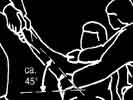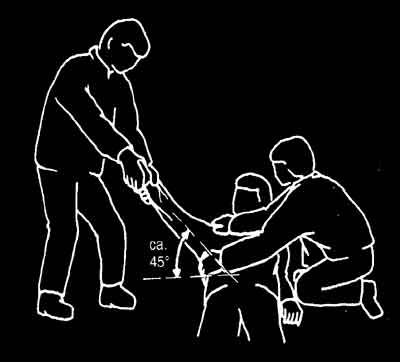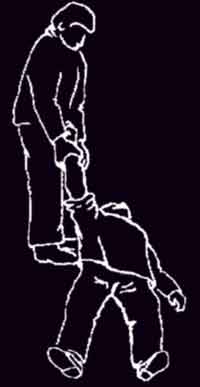[please login to make this ad block disappear]
Articles
Treatment of Shoulder Dislocations
 |
This article has been available on the Internet for a while now, but only as PDF and MS-word files. We hope to make it available to a wider audience by re-publishing it in html format on Playak. |
By Herbert Forster & Ken Zafren. Paper originally intended for mountain rescue first responders and rescue physicians according to national regulations.
Treatment of Shoulder Dislocations
Shoulder dislocations are very painful and sometimes are associated with neurologic and vascular injuries. If transport will be prolonged or difficult it is desirable to reduce the dislocation at the scene of an accident. This procedure is well accepted. If transport will be rapid (the normal case in European rescue conditions), the patient should be transported prior to reduction of the shoulder. The decision of whether to reduce a dislocated shoulder in the field requires balancing the desirability of early reduction against the risks involved.
Diagnosis and accompanying injuries
Anterior dislocation is the most frequent type and has a characteristic clinical picture. The shoulder is very painful. The patient holds the arm slightly abducted and externally rotated. In most cases, the patient supports the affected arm with the other one. Typically, the shoulder joint is locked and the arm cannot be adducted to the body. The empty glenoid fossa can often be palpated.
Accompanying bony injuries are quite frequent. Fractures of the head of the humerus can also be clinically similar to shoulder dislocation. Dislocation of the humeral head can lead to traction or pressure on the nerves. Brachial plexus injuries are present in 12% of shoulder dislocations, while axillary nerve injuries are found in 9%. Vascular injury is rare.
Treatment
If the diagnosis is not absolutely clear, reduction must not be attempted. In such cases, the arm should be splinted in the position that is most comfortable for the patient. Analgesic medicines may be given before splinting. A vacuum splint is ideal.
If reduction is to be attempted, discuss the proposed plan of action with the patient. Document neurovascular deficits which are present prior to reduction. Offer the patient analgesics and wait until the onset of pain relief. If two attempts are unsuccessful, the arm should be splinted. Overzealous efforts can do more harm than good.
Reduction should be primarily a responsibility of the physician, but can also be accomplished by rescuers with appropriate training. We recommend, without reservation, the use of the „Campell“ method in mountain rescue.
The patient will normally be found sitting or standing up. Explain the plan to the patient. The first rescuer grasps the injured arm at the inside of the elbow and applies traction along the axis of the arm. As if to shake hands, the rescuer gives the patient his or her hand (the right hand if the right side is dislocated, the left hand if the left side is dislocated). In this way, the traction that has been applied to the upper arm is transferred to the forearm. The hand that held the upper arm before, now grasps the wrist. The success of this reduction method depends on applying traction continuously, without interruption, to overcome the tension of the muscles.
Two Rescuers

At this point, ask the patient to lie down flat (supine) on the ground with the support of a second rescuer. Continue to apply traction with the arm abducted to 90 degrees and at a 45 degree angle to the ground. It is important for the second rescuer to provide countertraction. The position of this rescuer will be adapted to the terrain (see drawing).
One rescuer

Position the patient as for the two-rescuer technique with the arm at a 90 degree angle to the ground. Apply traction continuously The shoulder should be lifted slightly from the ground.
If the reduction is successful a pop may be heard or felt and the pain resolves almost instantly. After reduction, splint the arm and refer the patient to a physician for follow-up care.
| Copyright 1998 |
|||
| Authors: |
Herbert Forster MD |
Ken Zafren MD |
|
|
Accepted by the Commission for Mountain Emergency Medicine CISA – IKAR 1997 commission meeting Interlaken (CH) Reproduction is permitted and encouraged if the source is clearly indicated. | |||
| For reprints: |
Urs Wiget MD |
||
PS Another good document on the subject is available here.



